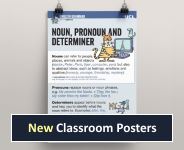Topic: Word structure
These resources cover the internal structure of words, including how words can be built up from smaller meaningful parts, and ways in which words can change their form in order to mark grammatical distinctions.
Englicious contains many resources for English language in schools, but the vast majority of them require you to register and log in first. For more information, see What is Englicious?

